Army Accelerates End-to-End Network Centricity
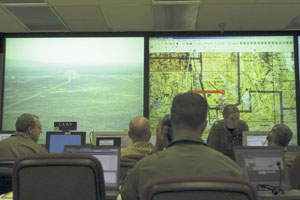 |
| Inside the Integrated Battlespace Arena at Michelson Laboratory during MILLENNIUM CHALLENGE 2002 (MC02), warfighters view real-time video from air assets, including a Predator unmanned aerial vehicle. According to Lt. Gen. Steven W. Boutelle, USA, chief information officer/G-6, U.S. Army, field exercises like MC02 contribute to efforts to move quickly toward network-centric operations. |
The U.S. Army is marching forward double time on several fronts to bring the power of networking to bear on the global war on terrorism. A number of efforts—some technological, others structural—aim at creating an information-based Army that can respond to threats quicker and effectively fight asymmetric enemies. Improved networking capabilities will affect how the service fights—from the individual soldier on the front line to those providing logistical support.
Changes taking place today are built on 17 focus areas identified by the Army’s senior leadership as key to winning today’s wars. The issues range from developing flexible, adaptive and competent soldiers to leveraging and enabling interdependent network-centric warfare to creating modular capabilities-based units. These efforts will transform the service from a traditional structure designed for fighting effectively during the Cold War to one that produces a force that is adept at fighting an adversary who has access to the same technological advances that it has.
Lt. Gen. Steven W. Boutelle, USA, chief information officer/G-6, U.S. Army, explains that the service’s emphasis on increasing network centricity is part of the overall U.S. Defense Department’s mission to share information within and between all the armed forces. Each service has developed its own comprehensive network. The Army’s version, called LandWarNet, mirrors the U.S. Air Force’s C2 ConstellationNet and the U.S. Navy’s FORCEnet (see page 23). Together, the three networks are referred to as the Joint Enterprise, which consists of the Defense Information Systems Network, the Global Information Grid–Bandwidth Expansion (GIG-BE) program, the Global Broadcast System and the Standard Tactical Entry Point (STEP) program, which are being converted into teleports. Future elements of this expansive network will include the Joint Tactical Radio System and the Transformational Communications Architecture satellite constellation. The Defense Information Systems Agency owns the Joint Enterprise; however, it is operated by the services.
Gen. Boutelle allows that the GIG-BE is one of the most important elements in pushing network-centric warfare from a concept to reality. He compares the increase in bandwidth to moving from a 4-square-foot doghouse into a 26,400-square-foot mansion, as speeds increase from 1.544 megabits per second to 10 gigabits per second. This effort gets information to the posts, camps and stations faster; however, it is still the service’s responsibility to improve capabilities within each installation, the general relates. The Army is accomplishing this task through its Installation Information Infrastructure Modernization Program, an effort the service will spend $429.1 million on this fiscal year.
Improvements underway in several other areas of communications also will facilitate network-centric operations, the general says. STEP sites, used for military communications and limited to accessing only military satellites, are being converted into teleports that can access commercial satellites and crosslink between the two. The first site already has been converted, and others will be converted during the next several years, he relates.
Satellite communications is one of the general’s key concerns. During recent operations in southwest Asia, 80 percent of the communications capability was facilitated by commercial satellites, while the other 20 percent involved military satellites. Gen. Boutelle would like to see these percentages reversed for several reasons. “We are heavily reliant on commercial satellites because our military satellite constellation has not kept up with the tremendous demand for growth of bandwidth. When our systems in the commercial and military world moved heavily into Web-based video teleconferencing, imagery, unmanned aerial vehicles and surveillance vehicles, there was this tremendous exponential growth in demand for bandwidth. Yet, satellite constellations take several years to design and launch. If you want something on a satellite, you’d better be looking at it seven to 10 years out.
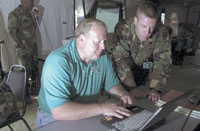 |
Richard G. Carlson (l) and Capt. Brian J. Lieb, USA, collaborate to download information to add to the scenario in the Kernel Blitz Experimental. The event involved a series of demonstrations and experiments that focused on the use of voice and data networks to link platforms and units in time-critical operations and the deployment of new technologies to link sea and ground forces. |
“We saw this exponential growth in bandwidth demand really at the same time Internet usage exploded in ’96, ’97, ’98, and yet the constellation of satellites that we have in the military and government were not equipped for this tremendous demand. So where do you get that capacity? You get that on commercial satellites. The upside of commercial satellites is that they are pretty much available worldwide. The downside is they’re very expensive and you tend to compete with industry for them. So if you move into someplace like southwest Asia, we’re competing with CNN, Fox News, MSNBC and everyone else for that commercial bandwidth. And, of course, they do not have the robustness and survivability of military satellites,” Gen. Boutelle says.
The Defense Department and federal government recognized these facts, and new satellite constellations will be launched. These will have a tremendous wideband capacity, beginning in 2005 with the wideband gap filler constellations up through the transformational communication systems that are slated to begin launching well after 2010, the general explains. Systems being built today, however, must be able to work with commercial satellites and be able to transition to the military constellations once they are available, he adds.
Another reason increasing military satellite capability is important is the move toward improving combat service support communities’ access. Today, personnel involved in command and control as well as intelligence have first priority. “In my mind, we will always lease a certain amount of commercial [satellite service], and that will be where we expand when we don’t have enough military satellite capability. But we must be prepared to pay the cost of doing that, and it can be very expensive competing with the commercial world,” he says.
Gen. Boutelle notes that work on each of the focus areas has been assigned to either the Army’s Training and Doctrine Command or the Army staff, and action has been taken in each area. For example, work on the active component and Reserve component rebalance is nearly complete; however, the general allows that some decisions remain about the proper mix. “Do we have the right mix of capabilities? Are the units the right units? Do we need to adjust those? In fact, in Iraq during operation Iraqi Freedom, we found that we had some battalions that were one of a kind. So we didn’t have the ability to rotate them, and we had to spend dollars commercializing the mission they were doing,” Gen. Boutelle relates.
In another transformational initiative, the Army is moving forward with what the service calls modularity, the general relates. The 3rd Infantry Division (3rd ID) is the first division undergoing this transformation. Three brigades are being restructured into five rapidly deployable brigade units of action (UAs). Each one will be capable of being a joint task force, or it could be task-organized and integrated into another service to form a joint task force. The Army also has determined the Unit of Employment x (UEx) construct, which the general says is “about a divisional concept,” and is now working on the design of the Unit of Execution y (UEy), which would operate one level above the UEx. The capabilities of the UEx and UEy have not yet been determined.
Modularity makes UAs virtually interchangeable because they will have the same capabilities. As a result, a commander can mix and match units to meet the needs of specific missions. “So a UEx has an additional maneuver brigade, but you could also bring in more brigades from other UEx’s and mix them in,” Gen. Boutelle explains.
In terms of network-centric operations, this modularity will standardize the mix of communications systems, and UAs will be nested within the Joint Enterprise. “So where you get the true power of network-centric warfare is when you can put that brigade in and plug it into that much larger global enterprise to allow you to move quickly across and around the globe. Command and control, graphics, logistics, telemedicine, all those pieces are where you get the power of network-centric warfare,” the general states.
Gen. Boutelle emphasizes that the changes occurring in the Army are happening at an accelerated pace. He explains that, in a peaceful environment, new equipment purchases that support transformational efforts like the move to a modular force would be part of the Program Objective Memorandum (POM). Currently, the Army is working on the 2006 POM, which means that many of the changes could not occur until fiscal year 2006. Because of the current state of emergency, the Army is leveraging supplemental funds to accomplish tasks quicker.
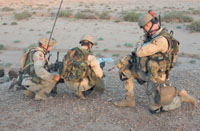 |
| Officers of the Pathfinder Company, 101st Airborne Division, maintain radio contact with their troops, while soldiers of the 2/502 Infantry Regiment, 101st Airborne Division, search a suspected terrorist camp in southwest Iraq last September. Long lead-time parts already have been ordered for the division’s equipment as that division is next to undergo transformation into units of action. |
“For instance, the 3rd Infantry Division is going back to Iraq, and most of the contracts for the networks for the 3rd ID were awarded in April. Equipment will start being delivered in August, and we will complete equipment delivery by November, do the training, do an operational assessment, and when they return to Iraq, they will have the new systems. We have already ordered the long lead-time parts for the 101st Airborne. We will do it next, and it will be an improvement over what we do in the 3rd ID.
“So as long as we have rotations, we will continue to use supplemental [funding] for units rotating into Iraq to upgrade those systems en route to the WIN-T [Warfighter Information Network–Tactical] program. And when WIN-T comes in, it will build upon the experiences in Iraq, Afghanistan and the work in the 3rd ID, the 101st and the other divisions,” the general explains. Experience gained from experiments, exercises and previous operations enables the Army to move at a faster pace because the service knows which pieces to pull together to accomplish the task, he adds.
WIN-T, a major Army program, currently is undergoing a substantial transformation. The general allows that he had several concerns about WIN-T primarily because the acquisition strategy was designed well before September 11, 2001.
Two contractor teams currently are competing for the final contract. However, today’s high operational tempo requires a change. Gen. Boutelle says that the Army leaders decided to re-examine WIN-T to determine whether the stated requirements address the Army’s focus areas and new modular structure. They also concluded that the service needs to evaluate the technology being used in southwest Asia and compare it to what the two contract teams are proposing. As a result, the service’s leaders have decided to choose a single lead contractor and bring in technologies much sooner and faster.
“One of my great concerns with WIN-T was that if we didn’t bring it in quicker, it would be so far out in years before we would bring it in—and cost so much money—that the system may never happen. So we need to bring it to the lab. We need it now; we need the pieces now, and so I think we’re doing the right thing for the warfighter,” Gen. Boutelle says. The details are still being worked out; however, the general predicts that a decision will be made in the next six to 12 months.
In addition to improving battlefield operations, network centricity will provide reach-back capabilities that will affect force structure, the general allows. Each time the Army moves forces into an area, it must carry with it all the necessary supplies to sustain the troops. “If you can leave anything back in a sanctuary or a safe area or even in the United States, perform the mission there and send the results of that forward, you have a tremendous savings. For instance, if you can leave your e-mail servers and the operators back and reach back for those services, you get an exponential growth effect. Because if you take several soldiers to operate them with you, then you need to take their sleeping bags and their cots and their tents, and then their meals for every day and their water and then any medical support. Then pretty soon you have to have power to run that server and the lights and then you have to have a generator. And if you have a generator you have to have fuel. And then pretty soon you need a truck to carry the fuel. Well, all of that was airlifted in. So once you put them on the ground, you have to continue that process, and you get this very large growth in support.
“Well, why can’t those servers be back here? In fact, in Afghanistan much of the e-mail that was done by the 10th Division was actually Web-based e-mail off Army Knowledge Online. In the Gulf today, in all of the Internet cafés where much of the e-mail is being done, they did not take their servers forward in all cases. They reach back for it on SIPRNET [secure Internet protocol router network] services, and they can do that because the servers sit back here in the United States or other places, and all you have to have is a satellite terminal and access. So let’s spend our resources on that reach-back of satellite terminals or getting into the GIG [Global Information Grid], and let people back in the United States run those services. They can go home at night, and they can live on posts, camps and stations, and you don’t have to carry all of those support pieces,” the general says.
 |
| Gen. Boutelle says that taking advantage of the reach-back capabilities that technology offers helps reduce the overall demand on logistics. For example, the servers for some of the Internet cafés in Iraq are located in the United States, so operators do not have to be deployed or to be supported in theater. |
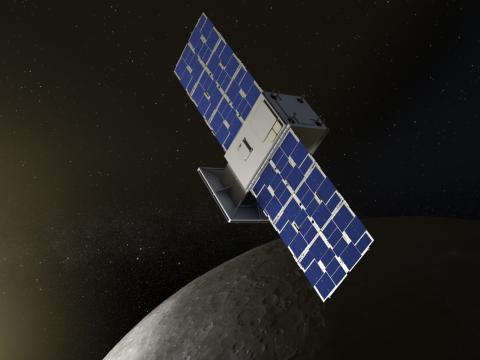
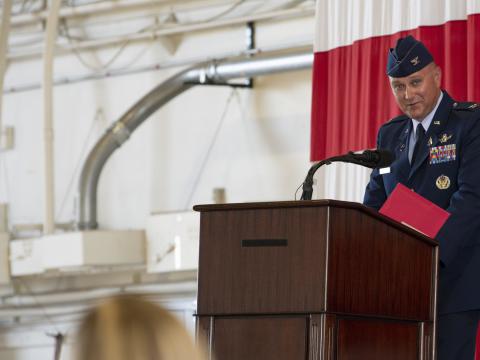

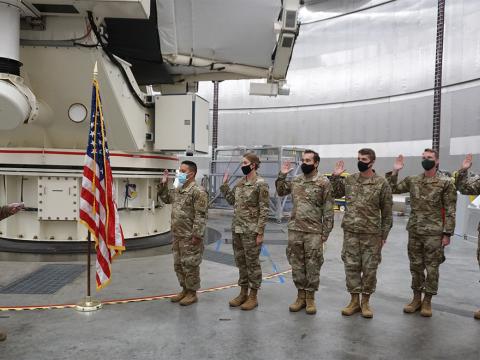
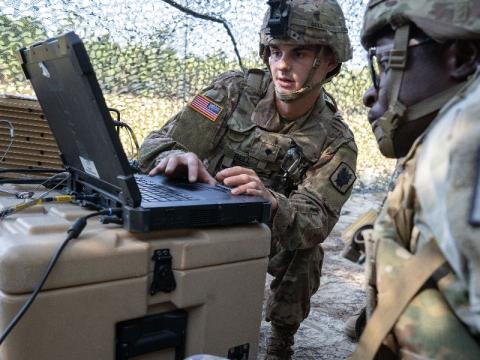
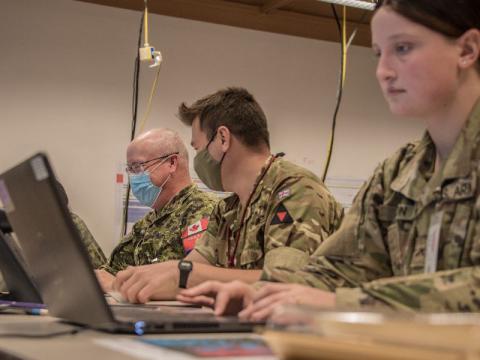
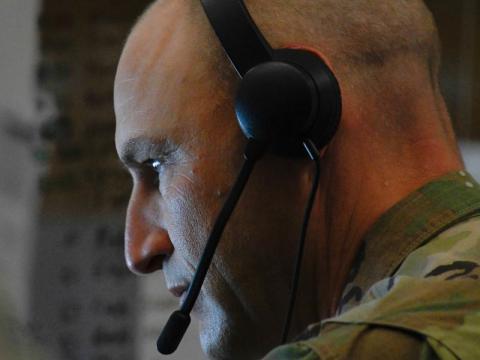
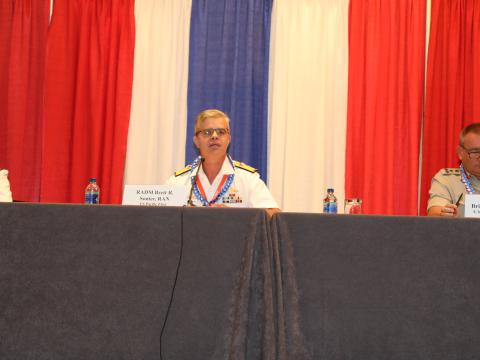

Comments